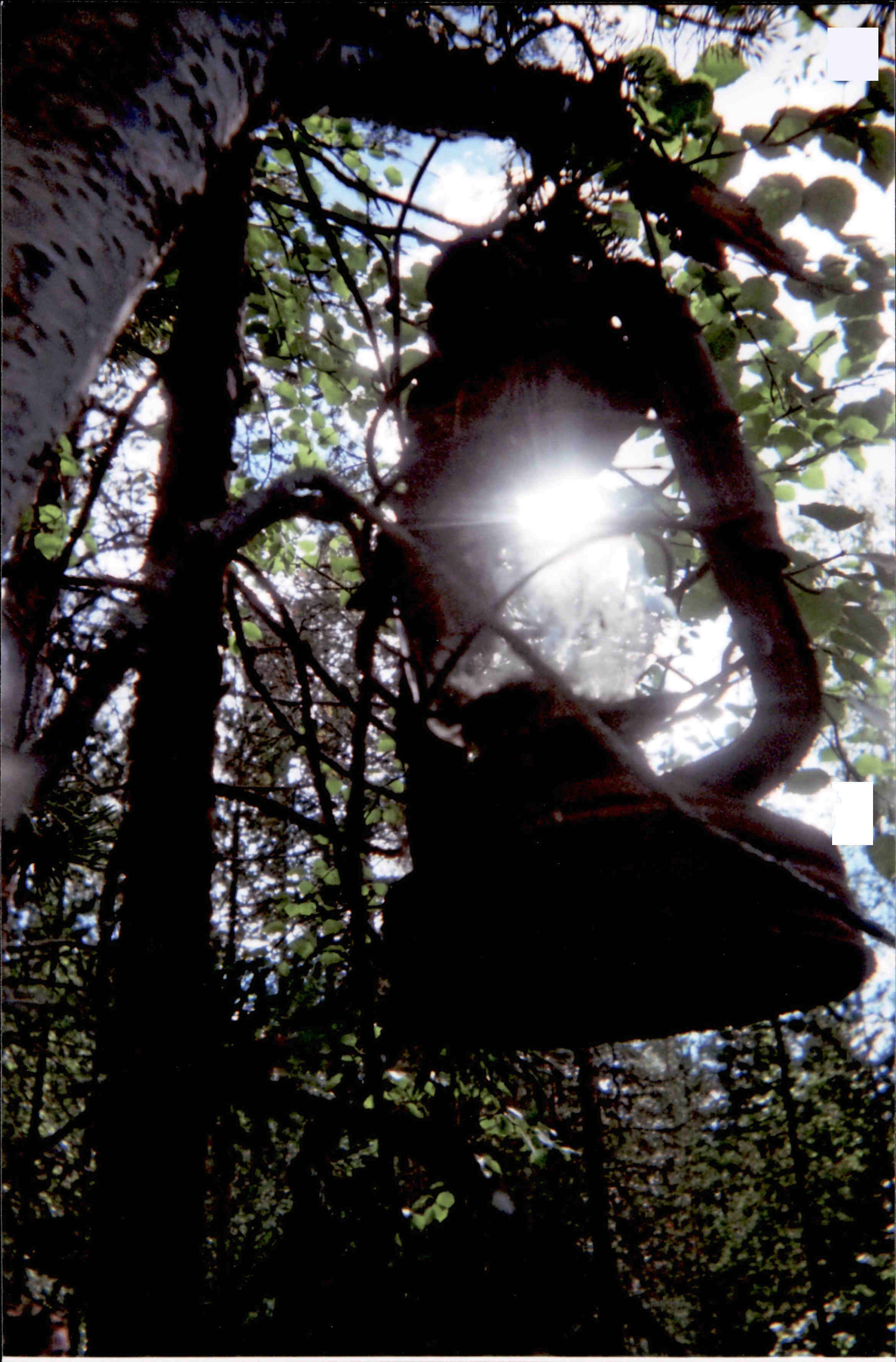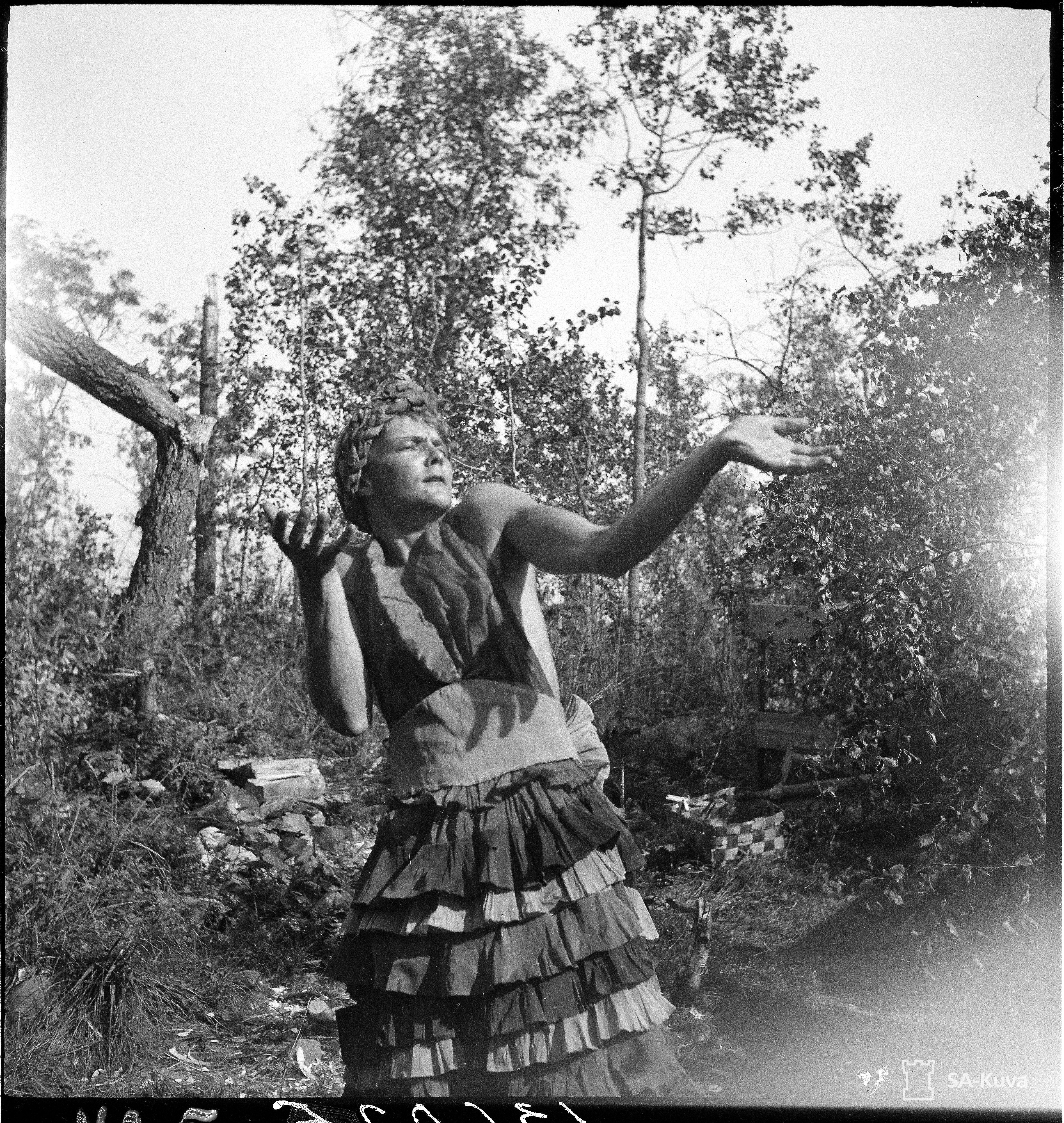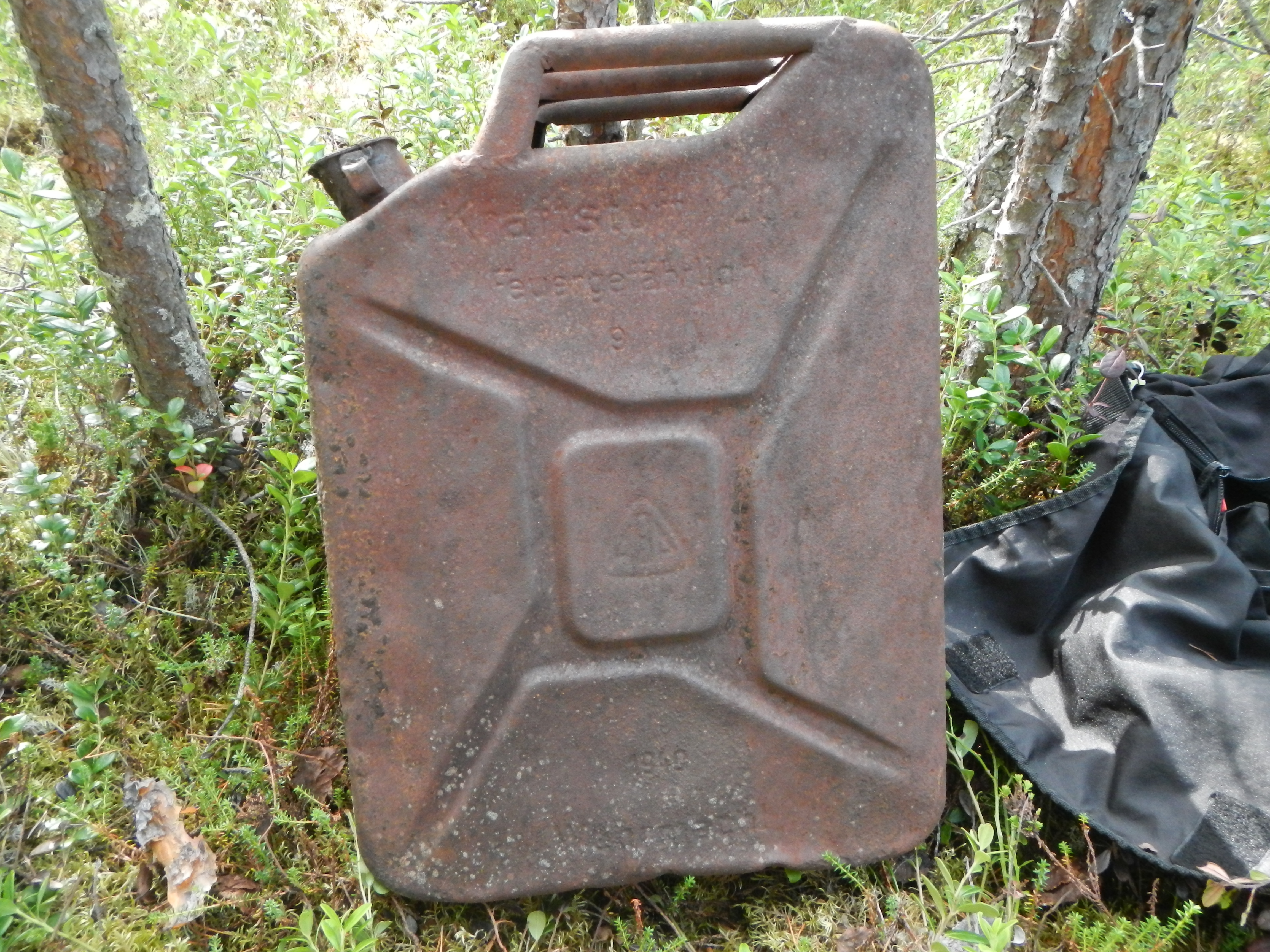Oula Seitsonen has been asked to present this week our studies for the science journalists from the Helsingin Sanomat and Tiede magazines, in a journalist-researcher meeting at the University of Helsinki. This informal get-together presents the wide range of research carried out at the moment in the humanities, from our WW2 material culture studies to linguistics research and Ancient Near Eastern Empires.
Author Archives: Deleted User
New on our YouTube Channel: Suzie Thomas talking about the research at the Cultybraggan PoW camp, Scotland
We have brand new content on the Lapland’s Dark Heritage YouTube Channel:
Suzie Thomas is talking in an in-depth interview about the community archaeological research at the Second World War Cultybraggan PoW camp for German prisoners of war in Scotland, and the heritage aspects of the site. This is a joint research project between the University of Helsinki and the University of Glasgow Centre for Battlefield Archaeology. Research at the Cultybraggan camp is directed by Dr. Iain Banks who has also been working several times with us in Lapland. Suzie’s fieldwork was funded by the Royal Society of Edinburgh / Caledonian Research Fund European Visiting Research Grant. Filming by Mousehole Films. Editing by Wesa Perttola.
Fröhliche Weihnachten! Buorrit Juovllat! Hauskaa joulua! Good Yule! Natale hilare et Annum Faustum! Glædelig Jul! Wesołych Świąt! Nadolig Llawen! С Рождеством!
“Rusina Serrato” performing in 1943 / “Rusina Serrato” esiintyy 1943 (suomeksi alla)
Related to the recording by Rosita Serrano that was identified from our excavations, we made today an interesting find in the Finnish Defense Forces photographic archive. We encountered this photo with the original caption “”Rusina Serrato’s” performance. Early August 1943″ (“Rusina” actually means “raisin” in Finnish), featuring a soldier in a dress, with some sort of “makeup” and a “wig”, apparently made of rags:
One can easily imagine how this performance was danced to the accompaniment of some Rosita Serrano recording, perhaps one of those in the previous post.
This image illustrates an interesting example of a cross-dressing performance in wartime conditions; these are relatively typical in frontal conditions when men are cutoff from the outside world for extended periods. This performance took place on the isolated Limosaari Island in the Lake Onega, and there are several other examples of cross-dressing in the archives from the same occasion (original captions):

Exotic and hairy-legged “hula girls”. Early August 1943. / Eksoottisia ja karvasäärisiä “hula-tyttöjä”. Elokuun alku 1943.

“Tom of Tinamäki” and “Big Ida” performing a peasant dance. Early August 1943. / “Tinamäen Tommi” ja “Iso-Iita” talonpoikaistanssia esittämässä. Elokuun alku 1943.
Teimme tänään mielenkiintoisen kuvalöydön liittyen kaivauslöytöjemme joukosta tunnistettuun Rosita Serranon levynpalaan. Törmäsimme SA-kuva-arkistossa tähän kuvaa, jossa kuvatekstin mukaan on käynnissä “‘Rusina Serraton’ esitys. Elokuun alku 1943”. Kuvassa esiintyy sotilas, jolla on mekko, jonkinlaista meikkiä naamassa ja “peruukki”, joka on ilmeisesti tehty jonkinsortin räsyistä:
On helppo kuvitella, kuinka tämä esitys on tanssittu jonkin Rosita Serranon levytyksen säestyksellä, ehkä yhden aiemmassa blogikirjoituksessa linkatuista levytyksistä soidessa.
Tämä kuva on mielenkiintoinen esimerkki ristiinpukeutumisesityksistä sota-ajan oloissa, mikä on ollut suhteellisen yleistä eri sodissa kenttäoloissa, kun miehet ovat olleet pitkiä aikoja eristyksissä ulkomaailmasta. Kyseinen esitys tapahtui Äänisen Limosaaressa, ja arkistoista löytyy useita muitakin kuvia ristiinpukeutumisesta samassa tapahtumassa (alkuperäiset kuvatekstit):
Archaeological afternoon / Arkeologian iltapäivä
Oula Seitsonen will be presenting our 2017 fieldwork in the Archaeological afternoon organized by the Department of Archaeology, University of Helsinki at Science Corner Lounge (Yliopistonkatu 4) on Monday December 11, at 2:25 pm:
“#Inaridig2: yleisö- ja yhteisöarkeologiaa 2. maailmansodan aikaisilla vankileireillä inarissa 2017″
Venue is open to the public, all are welcome!
Oula Seitsonen esittelee kesän 2017 tutkimuksiamme Helsingin yliopiston arkeologian oppiaineen Arkeologian iltapäivä -tapahtumassa Tiedekulma Loungessa (Yliopistonkatu 4) maanantaina 11.12. klo 14:25:
“#Inaridig2: yleisö- ja yhteisöarkeologiaa 2. maailmansodan aikaisilla vankileireillä inarissa 2017″
Tilaisuus on kaikille avoin, tervetuloa!
Program / Ohjelma:
Arkeologian iltapäivä
Tiedekulma Lounge, Yliopistonkatu 4, maanantaina 11.12.2017 Klo 12–17:30
12:15 Alkusanat – Antti Lahelma
12:20 Turpeen kätköissä ja vedenalaisessa metsässä – Lost Inland landscapes -projektin kenttätyöt Etelä-Karjalassa vuonna 2017 – Satu Koivisto
12:45 Artemis kumppaneineen. Arakhamitain Agia Paraskevin kaivaukset vuonna 2017 – Björn Forsén
13:10 Lasitutkimusta Skandinavian kaupunkikaivauksilla (Kööpenhamina, Nya Lödöse, Tukholma, Falun) – Georg Haggrén
13:35 Muinais-DNA tutkimusta Suomessa SUGRIGE-projektissa – Kati Salo, Elina Salmela
14:00 Pirkkalan Tursiannotko asutushistoriallisena kohteena – Sami Raninen
14:25 #InariDig2: Yleisö- ja yhteisöarkeologiset tutkimukset saksalaisten toisen maailmansodan aikaisilla vankileireillä Inarissa kesällä 2017 – Oula Seitsonen
14:50 Tauko
15:05 Raseborg revisited – uudet tulkinnat tulevan tutkimuksen ohjaajina – Tarja Knuutinen, Elina Terävä, Georg Haggrén & Maija Holappa
15:30 Asutusta etsimässä – Menetelmäkokeiluja itäisen Uudenmaan rautakautisen asutuksen löytämiseksi – Annukka Debenjak
15:55 Liike empaattisena menetelmänä – Marko Marila ja Suvi Tuominen
16:20 Tutkimukset Louhiveden Hietaniemen rituaalialueella – Jarkko Saipio
16:45 Hirvenhammaskorut, yhteisöt ja identiteetit noin 8200 vuotta sitten – Kristiina Mannermaa
17:10 Ancient Near Eastern Empires: Uusi huippuyksikkö selvittää Lähi-idän menneisyyttä – Antti Lahelma
17:25 Loppusanat – Elisabeth Holmqvist-Sipilä
17:30 Tilaisuus päättyy.
First record mystery solved! / Ensimmäinen levymysteeri ratkaistu!
The social media, citizen science and crowdsourcing really showed their worth for our research today, and in what a way!
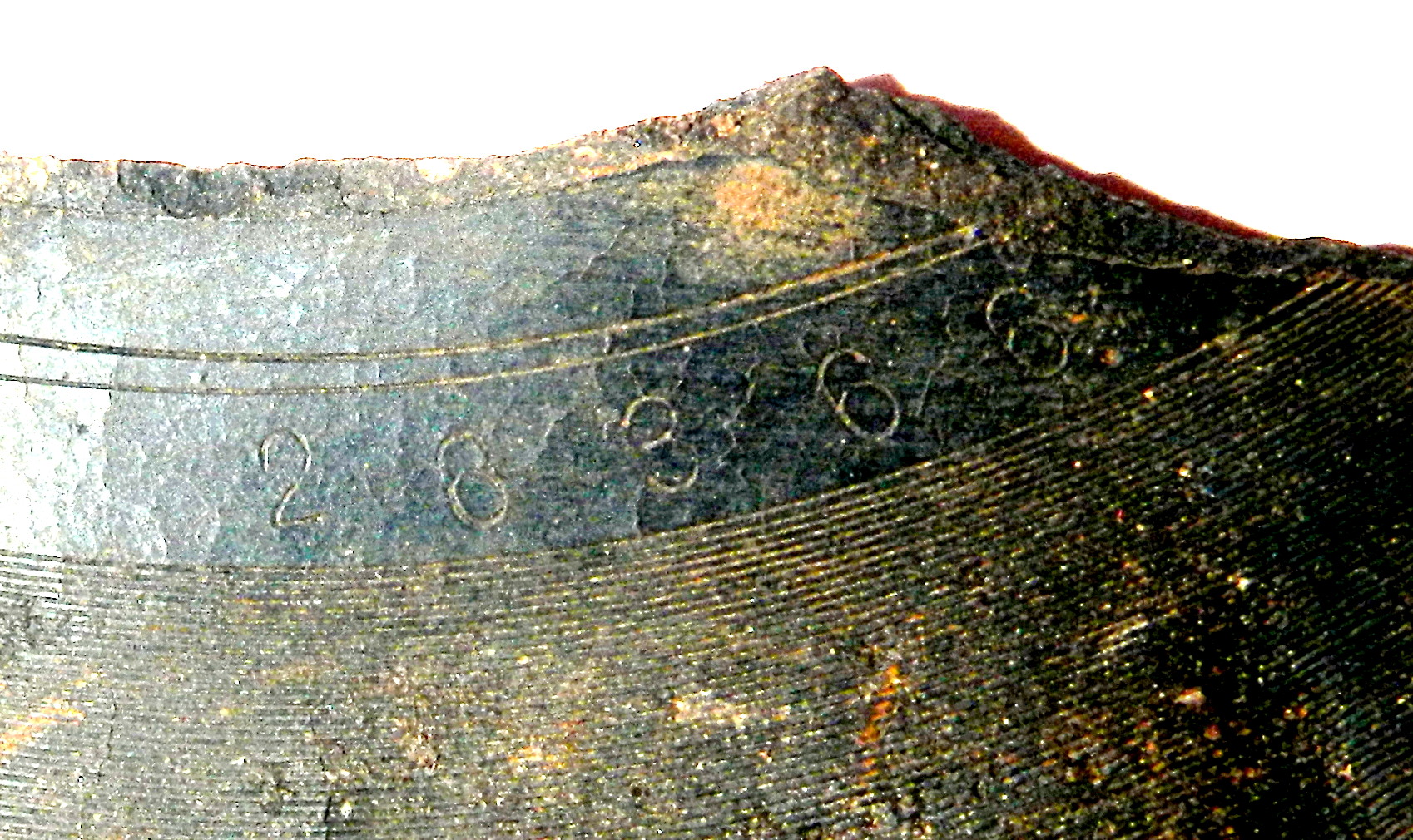
Record fragment with a master number (Photograph: Oula Seitsonen) / Levynpala, jossa näkyy levytyksen masterinumero (Valokuva: Oula Seitsonen).
We have now a positive identification for one of the gramophone record fragments we uncovered in a German WW2 trashpit at Inari Hyljelahti last summer, in less than a day after I posted online the picture of the master number on it (above) and a question of its possible origin! This amazing result is all thanks to the enthusiastic experts of a public Facebook group Schellackplatten – Börse who quickly narrowed down the options for this record fragment, identified it and even posted a picture of an unbroken copy of the record! (you can follow the interesting full discussion at https://goo.gl/CJMV1R).
Thanks to the enthusiastic contribution of these experts, we now know that the German soldiers at Hyljelahti listened to at least:
“Chilean Nightingale” Rosita Serrano‘s “Eine kleine Mondscheinfahrt” (A small moonlight trip) recording from 1942 (Telefunken nr. 26366)
Serrano’s version of the popular song “La Paloma” appears for instance in the movie Das Boot.
This is a first step to reconstructing the soundscapes of war inside a German military and PoW/forced labour camp deep in the Finnish Lapland Wilderness. We will keep posting about new results as we get them!
Here you can hear the song and see the singer Rosita Serrano at YouTube!
https://youtu.be/AvZADqxjpRU
9.12.2017: On the B-side of the record a “German tango” O, Manuela:
Sosiaalinen media ja suuren yleisön osallistaminen todellakin osoittivat kyntensä tutkimuksellemme tänään, ja todella upealla tavallla!
Olemme saaneet ensimmäisen tunnistuksen viime kesänä Inarin Hyljelahdesta saksalaisesta roskakuopasta kaivamistamme gramofonilevyn kappaleista! Alle vuorokausi siitä, kun postasin verkkoon kuvan levynpalassa näkyvästä levytyksen masterinumerosta (kuva yllä) ja esitin kysymyksen sen mahdollisesta alkuperästä, saimme jo tunnistuksen. Nopea tulos kyselyyn on täysin julkisen Schellackplatten – Börse Facebook-ryhmän innokkaiden levyasiantuntijoiden ansiota! He pystyivät nopeasti haarukoimaan eri mahdollisuudet mistä levystä kyseinen masterinumero voisi olla peräisin, tunnistivat levytyksen, ja lähettivät jopa valokuvan saman levyn hyväkuntoisesta kopiosta! (voit lukea koko kiinnostavan keskustelun täältä https://goo.gl/CJMV1R).
Näiden asiantuntijoiden innostuneen osanoton ansiosta tiedämme nyt, että saksalaiset sotilaat kuuntelivat Hyljelahdessa ainakin:
“Chilen satakielen” Rosita Serranon “Eine kleine Mondscheinfahrt” (Pieni kuutamoretki) -levytystä vuodelta 1942 (Telefunken nr. 26366)
Serranon versio suositusta “La Paloma” -laulusta on kuultavissa esimerkiksi Das Boot-elokuvassa.
Tämä on ensimmäinen askel syvällä Lapin erämaassa sijainneen saksalaisen sotilas-, vanki- ja pakkotyöleirin äänimaiseman rekontruoimiseksi. Kirjoitamme uusista tuloksista sitä mukaa, kun saamme niitä!
Yllä olevissa YouTube-pätkissä voit kuunnella koko laulun ja nähdä laulajan Rosita Serranon!
9.12.2017: Levyn B-puolelta löytyy “saksalainen tango” O, Manuela.
A puzzle of German WW2 records / Palapeli saksalaisten toisen maailmansodan aikaisista levyistä
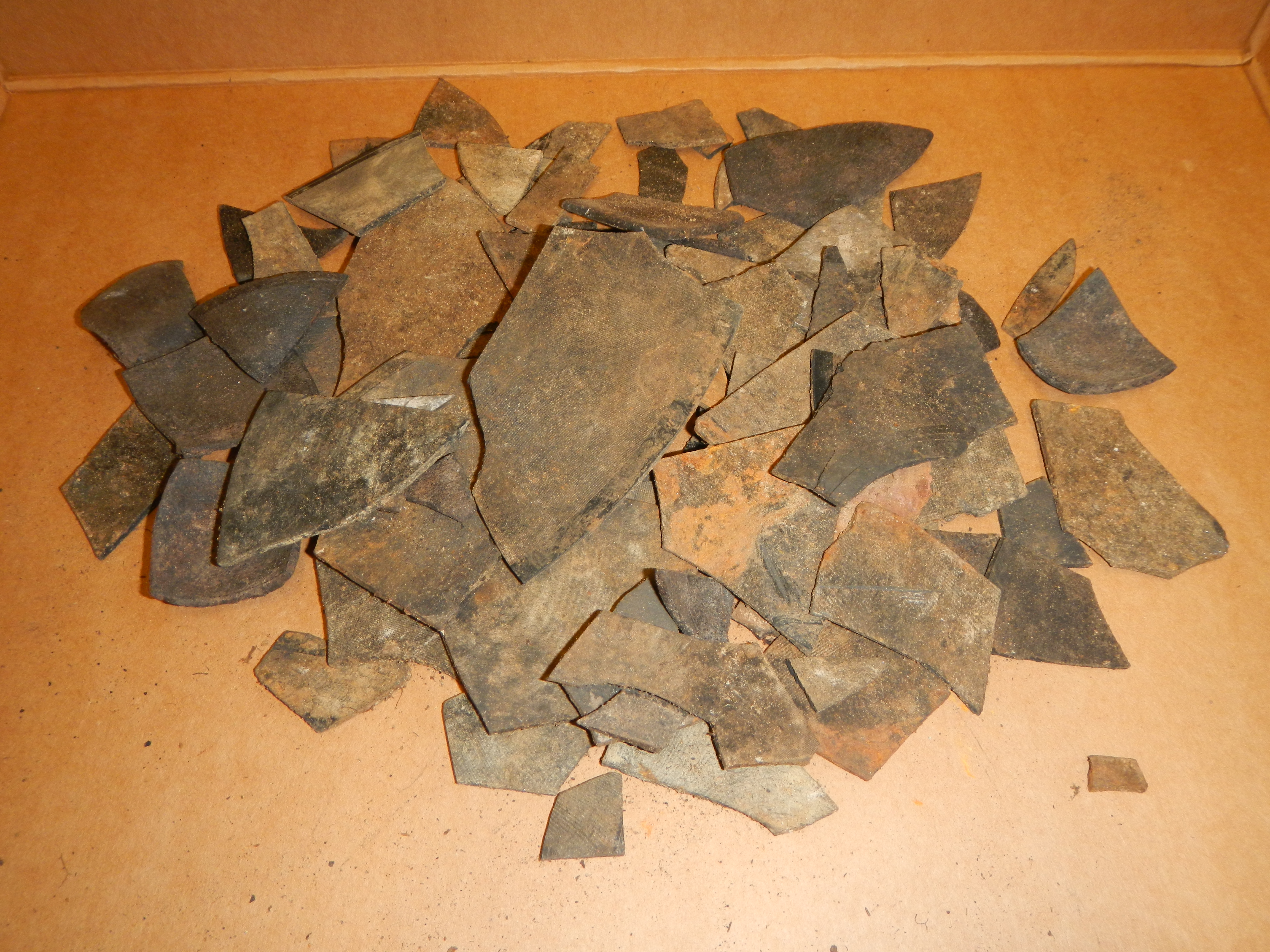
WW2-era gramophone record fragments (Photograph: Oula Seitsonen) / Toisen maailmansodan aikaisia gramofonilevyn sirpaleita (Valokuva: Oula Seitsonen).
Refitting, the art of putting scattered pieces recovered during the excavations back together, is a common method in archaeology. It is most often applied in the context of lithic and ceramic studies. However, in the aftermath of the #InariDig2, we have encountered a new kind of refitting puzzle, consisting of German WW2 gramophone record fragments.
Gramophone record fragments were dug from a trashpit at Inari Hyljelahti, the German military base and prisoner-of-war camp we studied this summer in our community and public excavations. Some of the fragments were burned and bent beyond recognition, but some of them are in a better condition. Based on the refitting, these appear to originate from at least three different records, probably smashed into the trashpit during the evacuation of the camp in Lapland War in autumn 1944.

Refitting record puzzle (Photograph: Oula Seitsonen) / Levypalapelin kasaamista (Valokuva: Oula Seitsonen).
So far we have managed to refit some sections of the records, and some of the fragments show relatively well preserved grooves. At least one of them has been manufactured by the Electrola company based on the fragmentary label, but none of the label fragments gives any hint of what has been on the records. Next question is, could there be anything recognizable left of the recordings on the discs, after lying over 70 years in small pieces underground, and how those sounds could possibly be extracted from the grooves? This could reveal us what the German soldiers and their Polish, Norwegian and other prisoners and forced labourers were listening at Hyljelahti during the war.
A handful of international research projects are developing approaches for reading old gramophone and vinyl records using digital methods, and there are some ideas of how this could be achieved with, for instance, a combination of laser scanning and various computer algorithms. We will explore these methods further over the winter.
Developing these kinds of methods is actually relevant also beyond the Hyljelahti fragments of (presumably) Nazi gramophone discs and whatever music or other recordings they might have contained. In many countries archaeologists engage already routinely in the study of sites from the early 20th century (not so often in Finland), and broken gramophone and vinyl records are one find category that archaeologists will be increasingly encountering during the excavations in future. Thus the development of computer-based “digital gramophone” methodology can be highly relevant thinking of the future of archaeology and the range of analyses the future archaeologists might need.

Archaeologist Wesa Perttola pondering upon the research possibilities of the record fragments (Photograph: Oula Seitsonen) / Arkeologi Wesa Perttola pohtii erilaisia levynpalasten tutkimusmahdollisuuksia (Valokuva: Oula Seitsonen).
Uudelleensovittaminen (refitting), eli sekalaisten arkeologisilla kaivauksilla löydettyjen palasten yhteenkokoaminen, on tavallinen arkeologinen tutkimusmenetelmä. Yleisimmin sitä hyödynnetään kiviesine- ja keramiikkatutkimuksissa. #InariDig2 -kaivauksemme jälkitöiden yhteydessä olemme kuitenkin törmänneet varsin toisenlaiseen uudelleensovituspalapeliin, joka koostuu saksalaisten toisen maailmansodan aikaisten gramofonilevyjen sirpaleista.
Gramofonilevyn kappaleet löytyivät viime kesänä roskakuopasta Inarin Hyljelahden saksalaisen sotilastukikohdan ja vankileirin yhteisö- ja yleisökaivauksilta. Osa palasista on palaneita ja taipuneita, mutta jotkin niistä ovat paremmassa kunnossa. Uudelleensovittamisen perusteella ne ovat peräisin ainakin kolmesta levystä, jotka on ilmeisesti paiskattu roskakuoppaan leirin evakuoinnin yhteydessä Lapin sodan aikana syksyllä 1944.
Tähän mennessä olemme onnistuneet sovittamaan joitakin osia levyistä ja joissakin palasissa myös urat ovat säilyneet suhteellisen hyvin. Ainakin yksi levyistä on repaleisen etiketin perusteella Electrola-yhtiön valmistama, mutta yhdessäkään etiketin palassa ei ole säilynyt vihjeitä siitä, mitä levyille on ollut nauhoitettuna. Seuraava kysymys onkin, olisiko mahdollista, että levynsirpaleissa olisi säilynyt jotain tunnistettavaa levytyksistä vielä 70 vuoden maakerroksissa makaamisen jälkeen, ja olisivatko nämä äänet mitenkään vielä tiristettävissä esiin levyjen urista? Jos tämä olisi mitenkään mahdollista, meille voisi paljastuisi mitä saksalaiset sotilaat ja heidän puolalaiset, norjalaiset ja muut vankinsa ja pakkotyöläisensä kuuntelivat Hyljelahdessa sodan aikana.
Muutama kansainvälinen tutkimusprojekti kehittelee tällä hetkellä digitaalisia menetelmiä, joilla olisi mahdollista lukea vanhoja gramofoni- ja vinyylilevyjä, ja on olemassa joitakin ideoita siitä, miten tämä olisi mahdollista esimerkiksi laserkeilausta ja erilaisia tietokonealgoritmeja yhdistelemällä. Tutkimme näitä menetelmiä ja niiden sovellusmahdollisuuksia tarkemmin talven kuluessa.
Tämänkaltaisten menetelmien kehittäminen on itse asiassa merkityksellistä myös laajemmin kuin vain Hyljelahden (oletettujen) natsigramofonilevynpalojen ja niiden sisältämän musiikin tai muiden levytysten osalta. Monissa maissa arkeologit tutkivat jo rutiininomaisesti myös 1900-luvun alkupuoliskolle ajoittuvia kohteita (Suomessa ei tosin kovin usein), ja rikkoutuneet gramofoni- ja vinyylilevyt ovat yksi löytökategoria, johon arkeologit törmäävät tulevaisuudessa tehtävillä kaivauksilla yhä useammin. Niinpä tietokonepohjaisten “digitaaligramofoni”-menetelmien kehittäminen voi olla hyvinkin oleellista, kun ajatellaan tulevaisuuden arkeologiaa ja tulevien arkeologien tarvitsemaa analyysikirjoa.
#InariDig2 in the international media / #InariDig2 kansainvälisissä uutisissa
Our last summer’s #InariDig2 public excavations were recognized also by the international media, besides Finnish media. Here is a list of the news in other countries that we have come across about last summer’s dig at Hyljelahti (Thanks to all our colleagues for pointing these out!):
Mörka krigsminnen grävs fram i norr http://www.vt.se/nyheter/morka-krigsminnen-gravs-fram-i-norr-ntm11856834.aspx
Finland gräver fram dystra minnen – gamla nazistläger undersöks https://www.svt.se/nyheter/lokalt/norrbotten/finland-graver-fram-dystra-minnen-gamla-nazistlager-undersoks
Финские историки прольют свет на судьбу советских военнопленных-евреев в фашистском лагере https://www.kompravda.eu/daily/26714/3740388/
В Лапландии начались раскопки на месте концлагеря для советских военнопленных https://ivbg.ru/7843918-v-laplandii-nachalis-raskopki-na-meste-konclagerya-dlya-sovetskix-voennoplennyx.html
Public excavation camp on WWII begins in Inari http://www.europe.easybranches.com/finland/Public-excavation-camp-on-WWII-begins-in-Inari-2111
Mörka krigsminnen grävs fram i norr http://www.nsd.se/nyheter/morka-krigsminnen-gravs-fram-i-norr-nm4612565.aspx
Kanadansuomalainen Meaghan Peuramäki-Brown tutkii Lapissa saksalaisten jäämistöjä (Kanadan Sanomat)
Viime kesän #InariDig2 yleisökaivauksemme huomioitiin kotimaisten medioiden lisäksi myös ulkomailla. Tässä on lista Hyljelahden kaivauksiin liittyvistä ulkomaisista uutisista, joihin olemme törmänneet (Kiitos kaikille kollegoillemme, jotka ovat lähettäneet linkkejä!):
Mörka krigsminnen grävs fram i norr http://www.vt.se/nyheter/morka-krigsminnen-gravs-fram-i-norr-ntm11856834.aspx
Finland gräver fram dystra minnen – gamla nazistläger undersöks https://www.svt.se/nyheter/lokalt/norrbotten/finland-graver-fram-dystra-minnen-gamla-nazistlager-undersoks
Финские историки прольют свет на судьбу советских военнопленных-евреев в фашистском лагере https://www.kompravda.eu/daily/26714/3740388/
В Лапландии начались раскопки на месте концлагеря для советских военнопленных https://ivbg.ru/7843918-v-laplandii-nachalis-raskopki-na-meste-konclagerya-dlya-sovetskix-voennoplennyx.html
Public excavation camp on WWII begins in Inari http://www.europe.easybranches.com/finland/Public-excavation-camp-on-WWII-begins-in-Inari-2111
Mörka krigsminnen grävs fram i norr http://www.nsd.se/nyheter/morka-krigsminnen-gravs-fram-i-norr-nm4612565.aspx
Kanadansuomalainen Meaghan Peuramäki-Brown tutkii Lapissa saksalaisten jäämistöjä (Kanadan Sanomat)
#InariDig: New publication about our community and public excavations in Inari / #InariDig: Uusi julkaisu yhteisö- ja yleisökaivauksistamme Inarissa (suomeksi kuvan alla)
We are glad to announce that Iain Banks (U of Glasgow), Eerika Koskinen-Koivisto and Oula Seitsonen have just published a new paper discussing our 2016 #InariDig community and public excavations in Inari in the Journal of Community Archaeology and Heritage.
Their abstracts tells us:
Research project Lapland’s Dark Heritage organized a one-week public excavation in Inari, Finnish Lapland, at a Second World War (WWII) German military hospital site in August 2016. #InariDig took place with the help of international experts and pre-registered volunteers. In this field report, two of the archaeologists leading the excavations and an ethnographer who took part in documenting this community archaeology experiment introduce the excavation sites and activities reflecting on the engagements with volunteers and local community.
50 quickest can get a free pdf copy of the paper by clicking this link:
http://www.tandfonline.com/eprint/QkbpZdVDszcpbrthwP7X/full

Local historian Matti Lehtola directing a historical war tour in Inari / Paikallishistorioitsija Matti Lehtola johtaa sotahistoriallista kiertokäyntiä Inarissa (Eerika Koskinen-Koivisto 2016).
Voimme iloksemme kertoa, että Iain Banksin (Glasgowin yliopisto), Eerika Koskinen-Koiviston ja Oula Seitsosen uunituore julkaisu on nyt saatavilla kansainvälisessä Journal of Community Archaeology and Heritagessa. Artikkeli käsittelee vuoden 2016 #InariDig yhteisö- ja yleisöarkeologisia tutkimuksiaamme.
Julkaisun tiivistelmä kertoo:
Lapin synkkä kulttuuriperintö -tutkimusprojekti järjesti viikon mittaiset yleisökaivaukset saksalaisten toisen maailmansodan aikaisessa sotasairaalakohteessa Inarissa elokuussa 2016. #InariDig toteutettiin yhdessä kansainvälisten asiantuntijoiden ja ennakkoonilmoittautuneiden vapaaehtoisten kanssa. Tässä raportissa kaksi kaivauksia johtanutta arkeologia ja etnologi, joka osallistui tämän yhteisöarkeologisen kokeilun kansatieteelliseen dokumentoimiseen, esittelevät kaivauskohteen ja -tapahtumat sekä arvioivat vapaaehtoisten ja paikallisyhteisön kanssa toimimista.
50 nopeinta klikkaajaa voivat saada ilmaisen pdf-kopion artikkelista tästä linkistä:
“Where the F… is Vuotso?”: Uusin julkaisumme vapaasti saatavilla / Our newest open access publication (English below the video)
Oula Seitsosen ja Eerika Koskinen-Koiviston juuri julkaistu tutkimus käsittelee toisen maailmansodan aikaisen evakuoinnin ja Lapin sodan tuhojen jälkeensä jättämää perintöä saamelaisessa poronhoitoyhteisössä Vuotsossa, Sodankylässä. Tutkimus on julkaistu kainsainvälisessä International Journal of Heritage Studies -julkaisussa, ja saatavilla kaikille avoimena (open access). Tutkimus on nimetty kunnianosoituksena Vuotsosta kotoisin olevalle Somby-yhtyeelle.
Julkaisun tiivistelmä kertoo:
Tässä artikkelissa käsittelemme toisen maailmansodan aikaisen evakuoinnin ja “Lapin polton” kulttuuriperintöä saamelaisessa poronhoitoyhteisössä ja arvioimme, miten nämä sota-ajan kokemukset ovat muokanneet ja muokkaavat edelleen tapoja, joilla ihmiset muistavat ja hyödyntävät toisen maailmansodan materiaalisia jäänteitä. Keskitymme tutkimuksessamme Vuotsoon, Suomen eteläisimpään saamelaisyhteisöön. Vuonna 1941 Natsi-Saksan joukot perustivat Vuotsoon suuren sotilastukikohdan, ja saksalaiset sotilaat ja kyläläiset asuivat läheisinä naapureina useiden vuosien ajan. Vuonna 1944 kyläläiset evakuoitiin ennen “Lapin sodan” puhkeamista. Lapin sodassa saksalaiset joukot tuhosivat sotilastukikohtansa ja kaikki siviilirakenteet. Tuhottujen saksalaisten sotilastukikohtien rauniot ovat edelleen nähtävissä kylän ympäristössä ja toimivat kyläläisille tärkeänä aktiivisena tekijänä tämän vaiheen muistamisessa. Saksalaisjäänteet näyttävät myös herättävän nostalgiaa sotaa edeltäneitä, itsenäisempiä aikoja kohtaan, ennen kuin perinteiset saamelaiset elämäntavat alkoivat nopeasti muuttua Suomen valtion voimakkaamman aktiviteetin seurauksena sodanjälkeisinä vuosikymmeninä.
Oula Seitsonen and Eerika Koskinen-Koivisto have just published their newest research about the heritage of Second World War forced movement and destruction in a Sámi reindeer herding community in Finnish Lapland at Vuotso, Sodankylä. Paper is available to all in the International Journal of Heritage Studies (open access). The title of our paper is a tribute to the Sámi rock band Somby originating from Vuotso.
The paper abstract states:
In this paper we discuss the heritage of the WWII evacuation and the so-called ‘burning of Lapland’ within a Sámi reindeer herding community, and assess how these wartime experiences have moulded, and continue to mould, the ways people memorialise and engage with the WWII material remains. Our focus is on the village of Vuotso, which is home to the southernmost Sámi community in Finland. The Nazi German troops established a large military base there in 1941, and the Germans and the villagers lived as close neighbours for several years. In 1944 the villagers were evacuated before the outbreak of the Finno-German ‘Lapland War’ of 1944–1945, in which the German troops annihilated their military installations and the civilian infrastructure. Today the ruins of demolished German military installations persist around the village as vivid reminders, and act for the villagers as important active agents in memorising this vital phase in Lapland’s recent past. They also appear to facilitate nostalgia for the more independent days before traditional Sámi lifeways were ruptured by stronger Finnish State intervention in the post-war decades.

